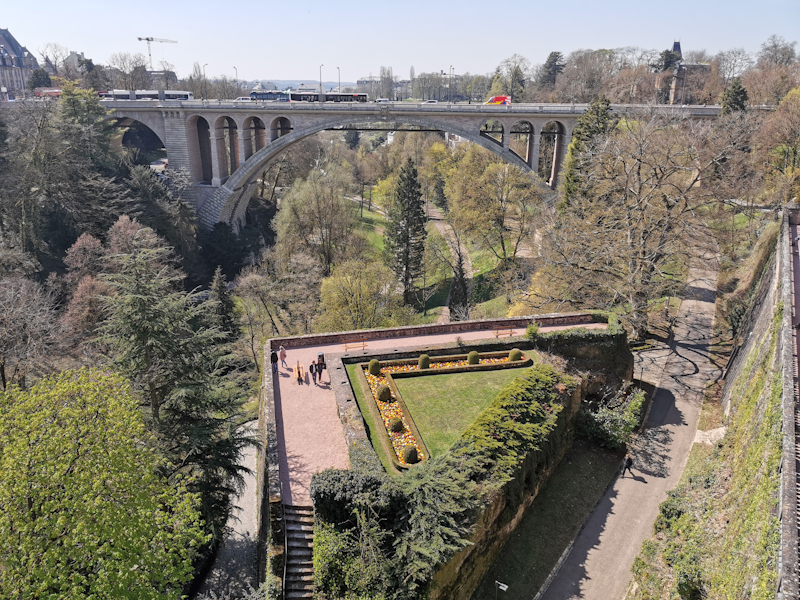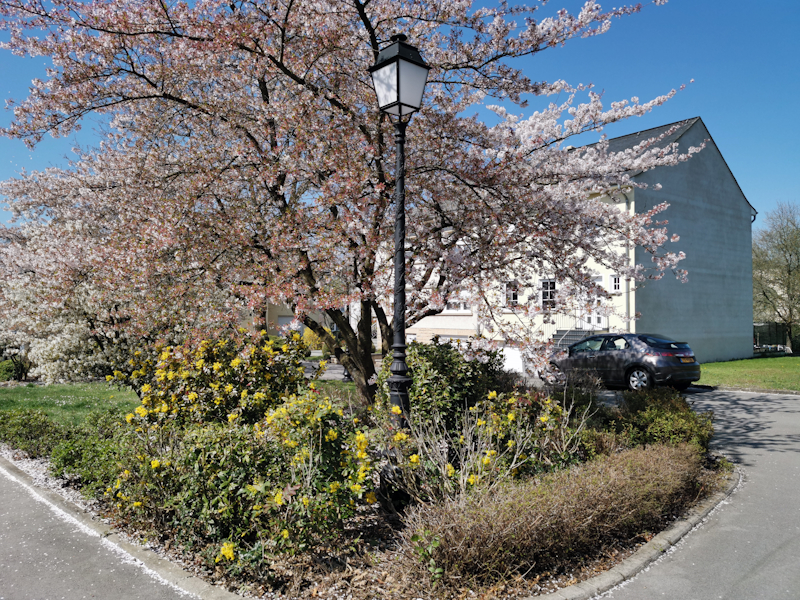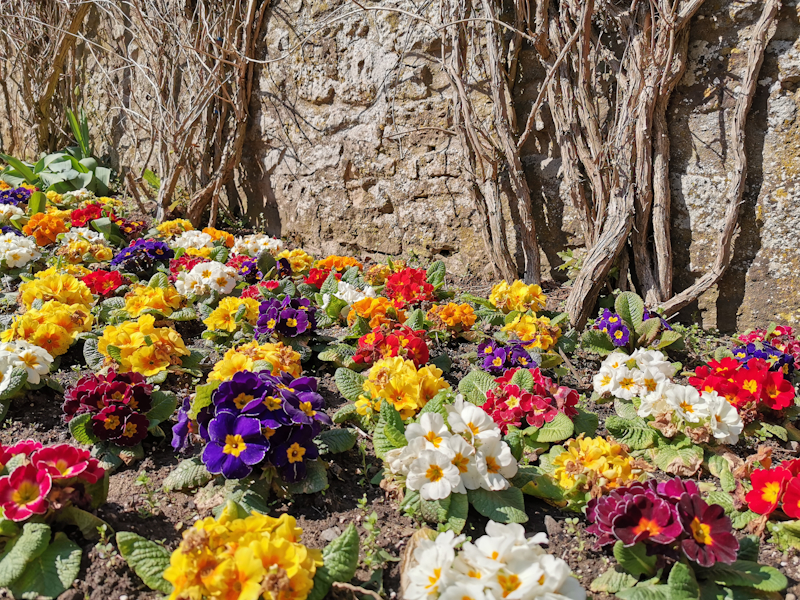The Huawei P30 & P30 Pro Reviews: Photography Enhanced
by Andrei Frumusanu on April 18, 2019 9:00 AM EST- Posted in
- Mobile
- Smartphones
- Huawei
- P30
- P30 Pro
Camera - Daylight Evaluation: Dynamic Range & Detail

[ P30 Pro ] - [ P30 ]
[ P20 Pro ] - [ P20 ]
[ Mate 20 Pro ] - [ S10+ (S) ]
[ S10+ (E) ] - [ S9+ (S) ] - [ G8 ]
[ G7 ] - [ V40 ] - [ View20 ]
[ OnePlus 6T ] - [ Pixel 3 ] - [ iPhone XS ]
Between the four Huawei 40MP sensor phones, the P30 Pro, P30, P20 Pro and Mate 20 Pro all produced vastly different results in their 10MP auto mode. The P30 Pro here produced a quite washed out image which was too desaturated, the P30 on the other hand was nearer to the actual scene. Both results have very different HDR processing compared to the P20 Pro which had a lot stronger processing going for it. The P30s produced more natural luminance gradients with less HDR artefacts.
Looking at the native 40MP results, all the phones have too dark results as the sensors lack dynamic range in this mode. What is also evident is that both the P30 units have trouble with resolving detail as well as the P20 Pro or the Mate 20 Pro. On one hand part of this is explained by the new optics with the wider aperture, particular some shots of the P30 Pro we see the shallower depth of field affecting details. On the other hand, this loss of detail is even present within the focal plane, and here the only explanation I have is that it’s either due to processing or simply the new RYYB sensor which isn’t able to achieve the same colour spatial resolution as the previous generation Bayer sensor.

[ P30 Pro ] - [ P30 ]
[ P20 Pro ] - [ P20 ] - [ Mate 20 Pro ]
[ S10+ (S) ] - [ S10+ (E) ] - [ S9+ (S) ]
[ G8 ] - [ G7 ] - [ V40 ]
[ View20 ] - [ OnePlus 6T ] - [ Pixel 3 ] - [ iPhone XS ]
This next scene with the cherry tree better demonstrates the weaknesses of the optics on the P30 Pro. Its wider aperture of f/1.6 versus the f/1.8 is visible in the outer parts of the image as things get blurred out because of chromatic aberrations. Again, this scene was extremely bright with the sun directly overhead. Both P30s in their native resolution showcase worse optics than the Mate 20 Pro which is able to get clean details throughout the scene without any haze. Again some of the loss in detail can’t be explained just by the optics, and here I think it’s again the sensor which might have a worse DTI implementation has Huawei’s previous 40MP units. These issues aren’t immediately visible in the 10MP shots as things become quite small.
This is a good opportunity to talk about Huawei’s Master AI mode; this had existed in past flagships in various iterations, but now Huawei has finally put a UI button switch directly in the camera interface. Last year this mode was a complete disaster with cartoonish contract and vignette effects, however starting with the Mate 20s it was a lot more toned down. For the P30s, I’ve found that in the vast majority of times it’s beneficial, such as in this sot a slightly bluer sky and a little brighter highlights.

[ P30 Pro ] - [ P30 ]
[ P20 Pro ] - [ P20 ] - [ Mate 20 Pro ]
[ S10+ (S) ] - [ S10+ (E) ] - [ S9+ (S) ]
[ G8 ] - [ G7 ] - [ V40 ]
[ View20 ] - [ OnePlus 6T ] - [ Pixel 3 ] - [ iPhone XS ]
This road scene again shows the optics differences between the P30 Pro, P30 and Mate 20 Pro. The larger aperture of the P30 Pro results in hazy details around the centre of the image, while the P30 doesn’t suffer as much. Still the Mate 20 Pro is far ahead of both in the optics and remains extremely sharp.
Again in the default mode the exposures are a bit too bland for the fact that the sun is directly overhead at noon – the AI mode again brings back a bit of saturation and highlights. Samsung and LG do a lot better here.

[ P30 Pro ] - [ P30 ]
[ P20 Pro ] - [ P20 ]
[ Mate 20 Pro ] - [ S10+ (S) ]
[ S10+ (E) ] - [ S9+ (S) ] - [ G8 ]
[ G7 ] - [ V40 ] - [ View20 ]
[ OnePlus 6T ] - [ Pixel 3 ] - [ iPhone XS ]

[ P30 Pro ] - [ P30 ]
[ P20 Pro ] - [ P20 ] - [ Mate 20 Pro ]
[ S10+ (S) ] - [ S10+ (E) ] - [ S9+ (S) ]
[ G8 ] - [ G7 ] - [ V40 ] - [ View20 ]
[ OnePlus 6T ] - [ Pixel 3 ] - [ iPhone XS ]
In the last scene we again see evident shallow depth of field of both units, with the P30’s focal plane being slightly nearer in this autofocus shot. On the P30 Pro you need to be aware of the new optics, as they can be a double-edged sword. On one hand it can give you natural blurring, but in some cases if you do not want the effect, you can’t do nothing about it, as opposed to say Samsung’s dual-aperture main camera.
The 40MP mode here is useless as while it captures a lot of detail, the dynamic range is severely lacking. Also this scene showcases the bad aspects of the AI mode; colours get far too saturated and unnatural.
P30 Pro & P30 Daylight Evaluation Conclusion
Overall, Huawei’s strategy in their camera hasn’t changed and what we’re seeing in the P30 Pro and P30 in terms of daylight capture continues the trends we saw in the P20s and Mate 20s.
In terms of versatility in different scenarios, the P30s are king. The inclusion of the trifecta of wide angle, regular and telephoto lenses means that you’ll be able to have the right camera at hand in the vast majority of cases. However this was also true for the Mate 20 released late last year.
So how do the P30’s differentiate? Well the P30 doesn’t try to do things much differently, and its camera setup is in line with what we found on the P20 Pro and Mate 20 Pro. This is not to say it’s bad, and the 3x telephoto zoom module is still unique to Huawei.
The P30 Pro’s 5x optical zoom module tries to do something special, and yes indeed it can capture things farther than any other phone out there. I do however have concerns on just exactly how useful this is in everyday usage, as I rarely find myself needing to zoom in quite that far. At 2x digital magnification/crop the P30s still hold up against the optical 2x modules because of the 40MP sensors, however going to 3x zoom we find that the P30 Pro finds itself in a quality gap until you go further to 5x. The bigger concern here is the f/3.4 aperture lens of the new module, and it’s evident that while it gets a lot of detail, its exposure isn’t quite the best.
The wide angle modules on both phones are great, but like on the Mate 20s, the Pro version has a better sensor that is able to capture more detail as well as have better dynamic range.
Processing on the P30s has changed a lot compared to the Mate 20s, however this is not always for a benefit. Sometimes HDR processing is a regression over the Mate 20s, however most of the time it does a better job. Colour rendition is also something the P30s sometimes seem to struggle and I did find some shots a tad too undersaturated, something that in the vast majority of cases is fixed by enabling the AI mode.
Speaking of the AI mode, compared to last year’s P20s, it’s a gigantic leap. This year it’s much more subtle and in the vast majority of cases it’s for the benefit of the scene. It’s only on rare occasions where it does go overboard.
Finally, the main optics of the P30 Pro and P30 feel like a slight disappointment to me. Particularly in the 40MP modes it’s evident that the lenses have seen downgrades compared to what we had in the Mate 20 Pro. The P30 Pro’s large f/1.6 aperture suffers more than the f/1.8 unit of the P30. In 10MP mode this is less immediately visible, however upon closer inspection it does result in less detail even in this mode.
I’m not certain if it’s due to the processing or the sensor, but even within the focal plane we’re seeing less detail sharpness. I very much think this is partly due to the new RYYB sensor which seemingly has lesser DTI (deep trench isolation) between the pixels.
Overall for daylight pictures, I come to the same conclusion I had on the P20 Pro, Mate 20 Pro and View20: These high megapixel sensors do not always achieve the best quality in well-lit scenarios. Huawei also needs to work on the composition consistency between the different camera sensors, there’s too many scenarios where the wide-angle, main camera as well as the zoom lens produce much too different results.










85 Comments
View All Comments
boozed - Friday, April 19, 2019 - link
Yeah nahs.yu - Thursday, April 18, 2019 - link
https://1drv.ms/u/s!Apr9zBuBUufHgaMUssv4Mh1vuyVh0gThis is P30P's often bragged about "50x zoom" at default magnification i.e. "zoomed out" vs. a 1" at "8x" zoom at 100% magnification. So you see with a premium compact like the Sony RX100IV or even a cheap one like Panasonic's ZS110 your *real optical* zoom combined with cropping could get you over "100x zoom" in Huawei's terms of usability.
Huawei could get you 5x but that's also worse than the 1" results notable at a glance except I forgot to make a screenshot of that.
Compacts are not dead.
s.yu - Thursday, April 18, 2019 - link
Typo, I meant the RX100VI.Quantumz0d - Thursday, April 18, 2019 - link
First thank you for posting that RX100 series shot. Some people think that real cameras are dead because of smartphones and their SW Gimmicks. The HW limitations truly show their stand. Not even Sony RX but even the old legend Nokia Pureview 808 or the Lumia 1020 have real purpose massive sensor with Xenon flash.Its a shame how so many cameras are being tacked on for marketing purposes, esp that night mode which kills the natural scene with over exposed unnaturally lit shot, a fake perception and deception.
boozed - Friday, April 19, 2019 - link
I thought the best part was the mainstream media fearmongering about the phone because of its "50x zoom". As if this is the first device to have a long focal length.s.yu - Friday, April 19, 2019 - link
It may be the first phone to allow 10x digital crop directly in the camera app though...?crotach - Tuesday, April 23, 2019 - link
DSLR has nothing to fear from these phones, it's a completely different world. MILC is taking care of the death of DSLR, but it will be a long and arduous death.Phones like these are responsible for the death of small compact cameras. These days I only see people buying the compact shooters for their kids, because they're much cheaper than a flagship phone. Give it a few more years and I doubt you'll find many compact cameras in the shops.
katsetus - Thursday, April 18, 2019 - link
Next time I'm planning a vacation, I'll keep Luxembourg in mind.Speedfriend - Thursday, April 18, 2019 - link
Apple is just so far behind in the camera now. Although having bought a P30 Pro, its speed in everyday use seems no faster and possibly slower than my Pixel 2 XL was. Battery life is insane though. Whereas my Pixel 2 XL was dead by the evening, the P30 Pro can make it to the next afternoonstar-affinity - Thursday, May 9, 2019 - link
At least the Iphones has video recording using 4K@60fps and the colours tend to be more natural compared to the P30 Pro in the comparisons I've seen. But sure the P30 Pro has many other advantages such as that nsane zoom and great low light performance.